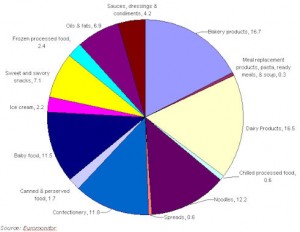Indonesian food processing raw materials sector in 2009
March 11 – The Indonesian food processing industry is predicted to grow and produce mass food product to cater for all levels of consumers with taste for Asian product. The opportunity for imported food ingredients is wider for such ingredients that are used to produce staple food and snacks.
Daily News Alerts
– We respect your privacy –
MARKET SUMMARY
The Indonesian food processing industry serving a population of 225 million offers significant market potential for U.S. suppliers of food and ingredients. In 2007, the product value of the Indonesian food processing industry was $41.7 billion, up 17 percent from 2006.
The industry consists of businesses of all sizes. About 6,100 large and medium-size producers account for over 80 percent of output and over 20 percent of the 3.36 million employees. The remaining 20 percent of processed food is produced in homes and sold on the street in roadside outdoor small restaurants, small roadside retailer kiosks called warungs, or on the street by vendors with small carts called kaki limas. Warungs, small restaurants along the road, and kaki limas are ubiquitous in Indonesia and provide a variety of meals and popular snacks for Indonesians. In Indonesia, giving food as a gift is a tradition and remains popular and snacking is very popular.
In 2007, Indonesia import $9.2 billion of agricultural, fish and forestry products with 16 percent coming from the United States. Australia is the second-largest supplier, accounting for 12 percent, followed by Thailand with 10 percent. Other suppliers do not account for more than 10 percent of imports individually. In 2007, over 40 percent of imported products by value were major inputs for food processing, such as wheat, sugar, dairy, soybeans, wheat flour, and beef.
Several factors contributing to the growth of the food processing industry are the introduction of new flavors and products, aggressive promotional activities, growth of modern retail outlets, and growing health awareness particularly among consumers who were educated in the west. In 2007, package food retail sales showed increases ranging from 2 to 18 percent in volume terms from the previous year and growth is expected to continue, ranging from 0.6 to 15 percent each year until 2012.
Healthy eating is becoming more popular among educated consumers particularly exposed to western-style products when living abroad and is featured by newspapers, magazines, and television. Food manufacturers are continually developing new products catering to health awareness trends and snacking. In addition, more women in urban areas are entering the workforce and prefer the convenience of processed food products.
More processors are finding adding value by fortifying their products. Currently wheat flour, dairy products, noodles, cookies, and frozen processed chicken fortified with minerals and vitamins are for sale in the market. Other products that are growing in popularity include functional packaged foods, breakfast cereals, fresh and pasteurized milk, yogurt, pasta, and frozen snacks, such as Chinese snacks shiumai, chicken and shrimp puffs, spring rolls, dumplings, and croquettes. Since the large majority of Indonesians are Muslim, most foods are produced using methods and products that meet halal requirements.
Foods sold in warungs and kaki limas tend to be traditional foods with familiar flavors. U.S. soybeans and beef offal are popular ingredients for traditional dishes such as tempe, bakso and meatballs. Soy milk in small single-serving plastic bags produced using a juicer or blender is becoming a popular option for a healthy beverage in both urban and rural areas. Fresh bakery products sold in shopping areas and malls are popular as gifts and snacks for the middle and upper classes. Indonesians will also visit high-end retail food stores to buy small packages of imported snacks.
Rice is a staple eaten at every meal. However, noodles from imported wheat are a popular substitute and use of wheat continues to grow. Dairy products continue to offer opportunities for U.S. milk powder to be mixed with fresh milk and as an ingredient. Indonesia currently only produces about 25 percent of milk production needs.
Though Indonesian ties to Europe remain strong and this influences taste choice and manufacturing methods, Australian, U.S., and Korean, and Japanese packaged foods are common as well. In Jakarta where about one-third of the upper and middle class live, foreigners from Asia are replacing western foreigners offering opportunities for Asian-style foods and flavors.
Smaller ready to eat packages are popular because of the lower price and the variety offered is increasing. Popular products include frozen poultry, frozen seafood, sausages, sugar confectionery, instant noodles, sweet and savory snacks, dairy drinks, and soft drinks. New brands and products with local flavors are also growing. All ages and income levels enjoy extruded snacks and other snacks of all kinds because snacking is a part of the Indonesian culture.
A troubling trend is the recent increase in trade protectionist measures by the Indonesian government. The upcoming elections, recent food safety scares, efforts to curb illegal imports, and the global financial crisis have prompted the FDA-equivalent National Agency of Drug and Food Control, or BPOM, and the Ministry of Trade to issue new requirements for packaged products and ingredients as well as resume implementing old decrees that were not being enforced.













Leave your response!